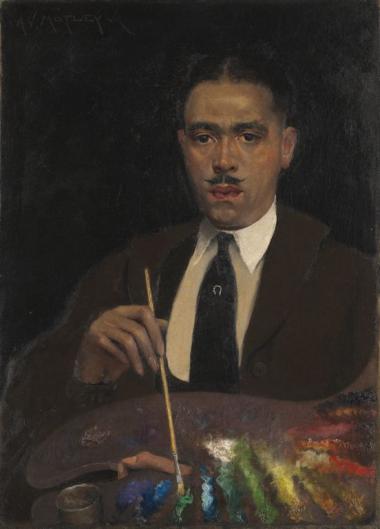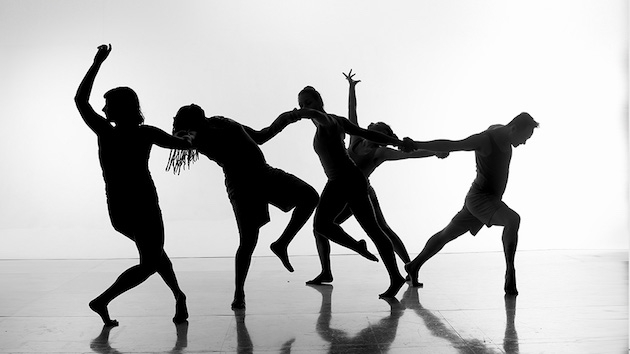
Viewing Nightlife (1943), Gettin’ Religion (1948), The Black Belt (1934), or most artwork by Chicago Jazz Age painter and Harlem Renaissance artist Archibald Motley (1891–1981), the immediate, striking feature of the human figures is their skin color. Deep burgundy, rose, peach, dark marine blue, moss green, mulberry purple, cantaloupe orange, creamy white — the wide spectrum opening across faces and bare arms is like a color wheel including almost every shade except black and brown. Which is counterintuitive because Motley’s subjects in soulful, exquisitely rendered portraits or kinetic, vibrant crowd scenes almost exclusively showcase people of color, most often African Americans. Black people, the paintings declare by extension, are not monochrome.
Subsequent impressions follow rapidly: themes of black identity, social change, cultural diversity, and migration emerge with a narrative drawn from timeless locations: urban streets, cafes and nightclubs, public parks, homes, churches. Everywhere, there are references to music and especially to jazz, found in upturned trumpets and horns, couples swing dancing in a blue-lit Paris nightclub, street musicians proliferating amid a crowd, a woman in an assembly hall with arms raised and mouth open wide in song. Capturing jazz’s improvisational flavor, the choreography of Motley’s animated compositions springs beyond consummate, stylized realism and rigorous classical technique into surprising distortion, a kaleidoscope of color, and, unmistakably, inspired genius.
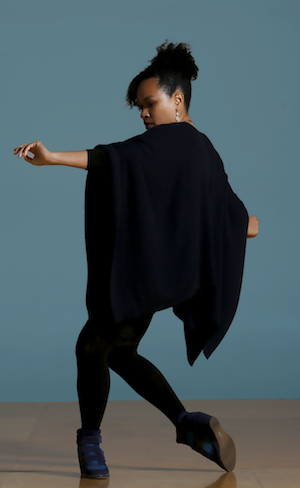
And so there’s no surprise that choreographer Raissa Simpson was mesmerized while walking through an exhibit at the Los Angeles County Museum of Art. Observing Motley’s paintings depicting scenes of black life and multiracial people whose saturated skin tones and positive atmospheres broke beyond racial tropes, Simpson found the cornerstone for a new work. PUSH Dance Company, founded by Simpson in 2005, presents the world premiere of The Motley Experiment, March 27–29 at Bayview Opera House in San Francisco. The evening-length work features original music composed and performed live by Idris Ackamoor and his sextet, The Pyramids.
Mirroring the project’s many shades, Ackamoor is a multi-instrumentalist, composer, actor, tap dancer, producer, administrator, and founder of the San Francisco performance company Cultural Odyssey. Operating under many hats, Ackamoor has collaborated with musicians, choreographers, orchestras, writers, and, under Cultural Odyssey’s music-theater-dance canopy, with longtime life/work partner Rhodessa Jones. A new double vinyl album, SHAMAN!, recorded by the sextet in early 2020 for Strut Records, is scheduled for release in June 2020. Three compositions including the title track from the album and an outtake are featured in The Motley Experiment.
In an interview, Ackamoor says the album was recorded over eight frenetic days during a two-month international tour that was astonishing. “Europe has been outstanding. I’ve been doing tours with 25 consecutive dates and fees from 1,500 to 6,000 [U.S. dollars] a performance. You don’t get that here in America.” The audience response, he adds, was impressive and more significant than the financial rewards. “Everywhere, we had sold-out houses, standing ovations, the reception has been enormous.”
Asked directly if the warm reception and spirit of “renaissance” for jazz he and the ensemble enjoyed in Europe is matched at home, in San Francisco specifically, Ackamoor’s response is blunt: no. Encouraged to articulate what is found elsewhere but missing in the United States and the Bay Area, he is unequivocal. “There is an African American arts crisis here in San Francisco. The situation belies a renaissance when there is no standalone African American theater. No one has their own building or venue. The Lorraine Hansberry Theatre founders both died [in 2010] and the organization was ousted even before then from its home. It’s a shadow of itself. We are very nomadic now.”
Ackamoor says his ensemble is reduced to rehearsing in his living room. A weekend retreat in collaboration with other African American theater groups and artists a few days after the interview, he says, will address the issue. “We have a struggle here. The migration of black artists from San Francisco is huge. This is about more than venue, it’s about self-preservation, identity, independence of idea, thought, and development. To nurture leadership, you have to have institutions that encourage creativity, places where artists can ply their craft. It’s obvious why we need a black theater. You have to have it to support African American playwrights, musicians, directors, and artists.”
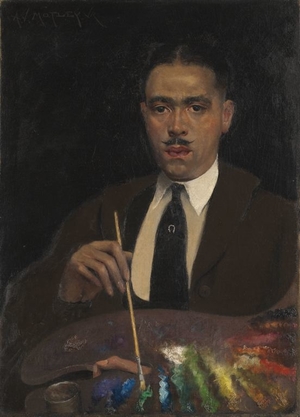
During the years of the Harlem Renaissance, Motley received rigorous training at the Art Institute of Chicago and, upon graduating from the prestigious, four-year program, was determined to present counterimages to the negative stereotypes about people of color. After some of Chicago’s worst race riots in 1919 and later during the 1950s and ’60s Civil Rights era, his paintings primarily featured upscale African Americans in scenes of everyday life. By reflecting in a positive light people of color, black music and dance clubs, hotels, restaurants, businesses, and other establishments that had flourished during the Harlem Renaissance — not only in Harlem but in Chicago, Paris, and other cities — Motley hoped his art would influence public perception.
Ackamoor says street theater performances and small clubs or theaters throughout 21st-century Europe create a similar throwback environment to the energy of the 1920s and ’30s. Audiences get a thrill being close to an active musician or actor, he suggests. For that reason he often leaves the stage, saxophone in hand, and enters the audience to perform a solo. “We embrace it; we break that fourth wall all the time. I can be a part of an audience at the drop of a dime,” he says. “Sometimes we do a ritualistic entrance and get them to sing along or I go out and play in someone’s ear. It gives me a chance to play very soft, acoustic. Audiences love it because a community feeling is created.”
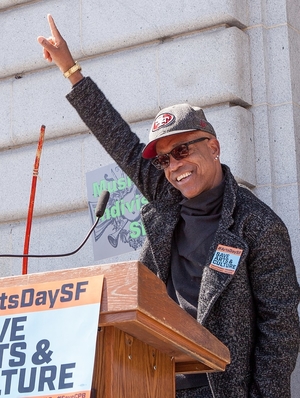
Shifting perspectives and proximity translates into the PUSH Dance production. During the performance the audience is free to stand, sit, or change their vantage point. The musicians will be positioned on an elevated stage overlooking the dancers’ main playing space. He says the acoustics of the ballroom are adequate, and with dynamics paramount, controlling the sound so he can play everything from “pianissimo to a scream” is most important. An audience that moves is nothing new, given his and the band’s fourth-wall-breaking habits and their history of performing on streets, in museums, galleries, music shops, dance clubs, jazz joints, and enormous, 5,000-seat concert halls filled with people dancing.
During the show, ensemble members are skilled in following the subtle body language Ackamoor uses — a hand wave, a tilt of the head — to be the “spontaneous conductor.” When selecting musicians for his band, he says, “Number one, I tell them to keep their eyes open. When you solo, you can’t close your eyes and go off in your own world in my band. You won’t last long that way with me.”
Performing the four tracks, “Shaman,” “Eternity,” “Virgin,” and “Beginning Roots,” will be Ackamoor (tenor saxophone, alto saxophone, keytar, vocals), Sandra Poindexter (violin, vocals), Margaux Simmons (flute, vocals), Bobby Cobb (guitar, vocals), Charles Thomas (electric bass), and Tony Price (congas). “Shaman,” Ackamoor says, flips the script about masculine emotions and has a man whose heart a woman has broken considering forgiveness. “Eternity” is about the afterlife; “Virgin” speaks impressionistically of a primordial forest; the avant-garde “Beginning Roots” is not on the album. “We did it in the recording studio. It’s about starting, commencing. It didn’t fit on the album. Raissa heard it because she had all the tracks at one time and loved it.”
About his second collaboration with Simpson, Ackamoor is sanguine. “As a composer, my main purpose is to support the choreographer’s vision. Raissa’s the conduit that takes the music and physicalizes it on the stage. I love it because I can just come in and support her.” People will choose how and what they hear in his music that infuses neo-African rhythms with free jazz, Latin jazz, gypsy folk, Ghanaian Afrobeat, keytar, violin, chanting, and spoken word. “Everyone will have their own story. That makes the best music: not having something shoved down their throats.”
Moving forward in his own cultural odyssey, we can only hope Ackamoor will follow Motley, who once said, “Artists feel that they’re more readily recognized in Europe than they are here in America. Well, me, I’m just a funny kind I’m telling you. I decided and I made up my mind, I said, I’m going to stay here, I’m not going anywhere, I’m not going to Europe. They’re not going to chase me out of my own country. I’m an American. I’m proud of being an American. I don’t give a damn what color my skin is, I’m going to stay right here and I’m going to fight it out, and I’m going to make my name right here. I’m staying right here in wonderful America.”

